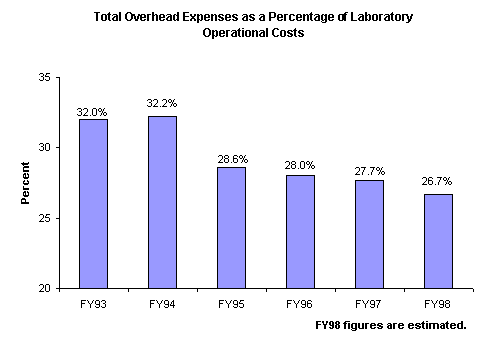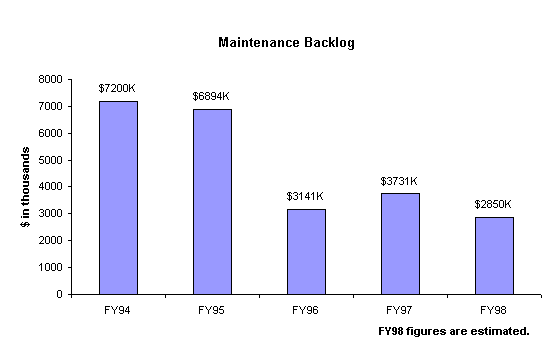 |
Written
Testimony of Dr. Charles V. Shank
Director,
Lawrence Berkeley National Laboratory
before the
House Science Committee
Subcommittees on Basic Research and
Energy and Environment
Wednesday, September 23, 1998 |
Mr. Chairman and members of
the Subcommittee, it is a pleasure to testify today about the
improvements in the efficient operation of the Lawrence Berkeley
National Laboratory since the Galvin Report was issued in 1995.
Just to reacquaint you, Berkeley Lab is the oldest of the DOE
national laboratories, founded in 1931 and located next door to
the University of California, Berkeley campus. Today we operate on
a budget of approximately $340 million performing research for the
Department of Energy (DOE), other Federal agencies and the private
sector.
The Galvin Report found DOE and its laboratory
system locked in an unproductive bureaucratic logjam. I am here
today to report that significant progress has been achieved which
has had an important impact on our productivity. I would like to
credit DOE for real and meaningful progress in managing its
laboratories more effectively. In addition, I am very appreciative
of the contributions of the Laboratory Operations Board,
particularly the external members of the Board.
New Operating Principles
We began making key steps toward improving
productivity even while the Galvin Report was being finalized. Our
first action was to work with our DOE Oakland Operations Office
(DOE-OAK) to establish an atmosphere of trust based upon a set of
mutually agreed upon operating principles. Working together we
developed seven principles which have allowed us to improve the
way we conduct business and to eliminate costly administrative
systems, unnecessary prescriptive oversight, and the diffusion of
responsibility characteristic of bureaucracies. We launched a new
era based on mutual trust in order to take unnecessary work out of
the system, while making sure that we are good stewards of the
taxpayers’ dollars. The principles were adopted in March 1995
with the signatures of DOE-OAK Manager James Turner and myself,
and they have guided what has developed into a very positive
working relationship since that time. We published the principles
in our Lab newspaper and made cards and posters that were
distributed to employees at both the Lab and at DOE.
The growing level of trust and mutual respect
between our two institutions has resulted in very positive results
that have saved the nation’s taxpayers many millions of dollars.
One example was the help we received from DOE’s Oakland office
to gain access to low-cost Federal power from the Western Area
Power Administration, saving $2.85 million since 1995.
DOE-OAK supported our development of an efficient risk-based
procurement system to cut red tape, reduce cost and expedite
purchases. The system is used in over half of our low-value
procurements, resulting in more than $500,000 in administrative
savings in FY 1998 alone. In FY 1997, DOE-OAK helped us overcome
many administrative obstacles to accelerate the leasing process
for new space for the rapidly growing human genome program, an
activity that would have been difficult or impossible in the
pre-Galvin era.
Our new working relationship has also improved our
operating activities, and has lead to the implementation of the
Integrated Safety Management Program and Work Smart Standards
Program, the Nuclear Regulatory Commission Pilot program, and more
effective contract management. We have implemented better and
smarter safety management and environment health and safety
programs that have retained the lab’s high standards in this
area while reducing unnecessary ES&H expenditures. We have
reduced the traditional, costly, large staffing scheme at DOE
sites that entails
"Checkers-checking-Checkers-checking-Checkers." We
worked with DOE to achieve cost efficiencies in their program for
implementing the National Environmental Policy Act, significantly
reducing the number of steps and the amount of paperwork passed
from office to office, while maintaining high standards of review.
We also improved our quality and cost effectiveness through
competitively procuring services to improve environment, health
and safety performance, including waste disposal, analytical
services, personnel protective equipment, and new safety training
programs.
Significant Progress in Cost Effectiveness
One element of our cost savings has been the
outsourcing of selected support functions to produce overhead
savings. Berkeley Lab has completely or partially outsourced more
than 25 functions, including security, travel, and mail services,
training, equipment maintenance, telephone installation and
vegetation management. We eliminated our printing plant and
central photographic processing facility and closed those shop
fabrication activities that could be conducted by local companies.
These latter steps also reduced sources of waste, with attendant
cost savings in waste management. The combined effort in
streamlining, outsourcing, and administrative systems updating
resulted in a reduction in our composite overhead rate of 17
percent.

The collective effects of these dramatic changes
have significantly reduced our operating costs, and allowed us to
deliver more research for every dollar invested in our lab. Our
streamlined support services allowed an 18 percent reduction in
personnel supported by our overhead budget. This means an increase
in the ratio of scientific staff to research support staff from
2.0 scientists per support staff in FY 1995 to 2.3 scientists per
support staff in FY 1998.
Reinvestment and Maintaining Assets
As I mentioned earlier, we are the oldest of the
DOE labs, so we have the oldest site with many maintenance needs.
One of the more exciting results of our efficiency initiatives is
that even while we have been reducing overhead, we have also
increased our investment in infrastructure improvements at
Berkeley Lab. We improved our physical plant, focusing on critical
maintenance issues. One key result of this effort has been a 50
percent reduction in the annual backlog of plant maintenance work,
and a corresponding reduction in demands for future infrastructure
projects, as is shown below.

We are now improving the life-cycle costs and
lifetimes of all of our buildings, through replacement of roofing
systems, air handling, heating and ventilation systems as
required, and installation of automated energy monitoring and
management systems. We are also outsourcing vehicle fleet
maintenance, renting rather than acquiring heavy equipment, and
reducing inventories. Thus, Berkeley Lab has been able to put more
maintenance resources into our facilities infrastructure and also
accomplish more with each dollar.
Sustained Management Reform
An important reform in the way the Department
manages its national laboratories has been realized through the
Laboratory Operations Board. I was privileged to serve as an ex-officio
member of that panel. I found it valuable to have all the DOE
senior management considering important Departmental issues around
one table, with the participation of external members from
industry, universities and government laboratories. The Board
began to undertake a series of reviews directed at improved
management and served as a very critical sounding board for
policies or activities that would impact the Laboratories. During
its first several years, the Board was co-chaired by Under
Secretary Charles Curtis and John McTague. It successfully
supported the reduction in burdensome DOE Orders and stopped
misguided attempts to saddle the Laboratories with unnecessary
centralized directives. One of the burdensome efforts stopped by
the Board was a bureaucratic attempt to combine the management of
administrative and scientific computing resources in DOE -- this
would have crippled DOE’s leadership in scientific computing
through controls that had no value for a scientific program.
This year, issues reviewed by the Board have
included: DOE’s scientific merit review processes, performance
benchmarking and deployment of productivity metrics, streamlining
reporting requirements, a mission review of the smaller
laboratories, an assessment of technical manager positions, and
discussions on contracting policies and practices. The Board’s
concern over management issues has maintained an environment that
encourages the cost and programmatic efficiencies that I have
discussed. It has led to better, more comprehensive decision
making in the Department, and has helped move DOE away from
so-called stovepipe management and towards programmatic and
institutional management. The Board is now co-chaired by Under
Secretary Ernest Moniz and Dr. McTague, who continue the efforts
at reform and the development of a more systemic framework for the
national laboratories.
By embracing the concept of a system of
laboratories and conducting research competitively through
performers that have the primary competency, DOE is making more
effective use of its national laboratories. A good example is DOE’s
Joint Genome Institute, a partnership between us, Livermore and
Los Alamos National Laboratories. The partnership is on track for
exceeding its FY 1998 DOE sequencing target, established last
year, of 20 million base-pairs. We are also responsible for
building the front-end accelerator for the new Spallation Neutron
Source to be built at Oak Ridge National Laboratory. Berkeley Lab’s
role in this project stems from its expertise in ion sources and
rf (radiofrequency) power supplies and other accelerator systems.
In partnership with the Stanford Linear Accelerator Center and the
Lawrence Livermore National Laboratory we are working towards
completion of the B-Factory project and the commencement of an
experimental program next year. With our expertise in synchrotron
accelerators, we have completed the design and fabrication of the
B-Factory’s Low Energy Ring, which is now undergoing
commissioning. Similarly, we are building an accelerator for a
stockpile stewardship project at the Los Alamos National
Laboratory. This accelerator for the Dual Axis Radiographic
Hydrodynamic Test Facility is based on the induction-linac concept
developed at Berkeley Lab over the past 15 years funded by DOE’s
inertial fusion energy science program. The advancement in
accelerator design from this challenging project will demonstrate
how Energy Research expertise can benefit Defense Programs. Also,
a very important consequence will be the benefit of increasing DOE
expertise in induction accelerators that can serve as drivers for
a future civilian fusion energy research program.
In each of these projects, DOE is taking advantage
of the unique strengths and capabilities of each institution. This
is a far more efficient process than building up new teams at each
site for each new project. It does require trust between the
participating institutions that they will devote the necessary
resources to successfully complete their portion of the project.
The reforms at DOE have been addressing findings
that Bob Galvin reported in 1995. We are working in greater
partnership among the Laboratories and with DOE to insure that our
laboratories remain focused on their missions, maintain their core
competencies and infrastructure, and conduct their business in a
cost effective manner. We are basing our relationships on new and
sound operating principles, and we are achieving continuous
improvements as I have related in this testimony.
Finally, I want to make a request of the members
of this Committee. You have been very supportive over the years of
the science performed by the Department at its national
laboratories, and of efforts we have jointly made to improve the
way we do business. We have been successful in both endeavors, and
I urge your continued support.
Thank you.